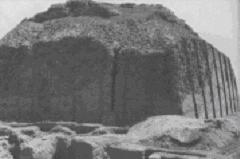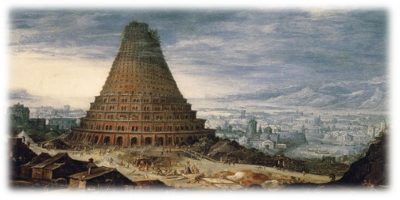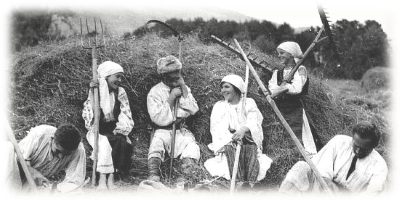When studying the origins of ancient languages, the Biblical account of the Tower of Babel must be considered. When was this Biblical account first written? Was the Tower of Babel fact or fiction?
Let us begin by examining the written account of the Tower of Babel as found in the book of Genesis. Below is Genesis 11:1-10 according to the King James Version.
1 And the whole earth was of one language, and of one speech. 2 And it came to pass, as they journeyed from the east, that they found a plain in the land of Shinar; and they dwelt there. 3 And they said one to another, Go to, let us make brick, and burn them throughly. And they had brick for stone, and slime had they for morter. 4 And they said, Go to, let us build us a city and a tower, whose top may reach unto heaven; and let us make us a name, lest we be scattered abroad upon the face of the whole earth. 5 And the LORD came down to see the city and the tower, which the children of men builded. 6 And the LORD said, Behold, the people is one, and they have all one language; and this they begin to do: and now nothing will be restrained from them, which they have imagined to do. 7 Go to, let us go down, and there confound their language, that they may not understand one another's speech. 8 So the LORD scattered them abroad from thence upon the face of all the earth: and they left off to build the city. 9 Therefore is the name of it called Babel; because the LORD did there confound the language of all the earth: and from thence did the LORD scatter them abroad upon the face of all the earth.

Did the actual Tower of Babel exist? Within the land of Sumer are many structures called Ziggurats meaning "high". The Ziggurats have names such as; "Temple of the Foundation of Heaven and Earth", "Temple that Links Heaven and Earth", "Temple of the Exalted Mountain", "Temple of Exalted Splendor", and "Temple of the Stairway to Pure Heaven". The Ziggurats were built with sun dried bricks, burnt bricks and bitumen mortar. These Ziggurats may not be the "Tower of Babel" but are most likely replicas of an older original.
When was this account written? There have been two possibilities proposed by scholars. The first is that the books of Genesis through Deuteronomy were written by Moses placing the writing around 1500 BCE. The second possibility is that it was written by a Jewish scribe or priest sometime around 500 BCE.
Regardless of the actual date of the writing, the question of the origin of the story remains. In ancient near east cultures, family and national historical accounts were meticulously and accurately passed down from generation to generation orally. Did the writer of the Genesis account record a traditional story or was it fabricated?
The Genesis account identifies the land of "Shinar" as the location of the Tower of Babel. This is the land of "Sumer" where many ancient documents of the Sumerians have been discovered. Within these documents are stories paralleling many of the Genesis accounts including creation, Noah and the flood as well as the confounding of the languages.
"In those days, the lands of Subur (and) Hamazi, Harmony-tongued (?) Sumer, the great land of the decrees of princeship, Uri, the land having all that is appropriate(?), The land Martu, resting in security, The whole universe, the people in unison (?) To Enlil in one tongue [spoke]. ... (Then) Enki, the lord of abundance, (whose) commands are trustworthy, The lord of wisdom, who understands the land, The leader of the gods, Endowed with wisdom, the lord of Eridu Changed the speech in their mouths, [brought (?)] contention into it, Into the speech of man that (until then) had been one. (translation from The Babel of Tongues: A Sumerian Version" by Kramer, S.N., Journal of the American Oriental Society 88:108-11,1968)
The Sumerian documents which include this account date back to about 3,000 BCE. Clearly, the account of the confusion of languages dates back long before the written Biblical record. The Biblical author of the Genesis account was in fact writing a traditional story and was not a fabrication on his part.
According to the Biblical account, all mankind migrated and settled in the land of Sumer after the flood. After the confusion of languages, the people scattered. If this were true, this amazing story would have been passed down from generation to generation throughout all of the different peoples and carried with them to their new settlements.
The Genesis stories including creation, the fall of Adam and Eve, the Garden of Eden, Noah and the flood, the Tower of Babel and the confusion of languages have been found in hundreds of cultures throughout the world such as the accounts below.
Mexico: And as men were thereafter multiplying, they constructed a very high and strong Zacualli, which means "a very high tower" in order to protect themselves when again the second world should be destroyed. At the crucial moment their languages were changed, and as they did not understand one another, they went into different parts of the world. (Reference: Don Fernando de Alvara Ixtlilxochitl, Obras Historicas Mexico, 1891, Vol. I, p. 12.)
Polynesia: But the god in anger chased the builders away, broke down the building, and changed their language, so that they spoke diverse tongues. (Reference: R. W. Williamson, Religious and Cosmic Beliefs of Central Polynesia Cambridge, 1933, vol. I, p. 94.)
American Indian, Crow: Then Little Coyote did something bad. He suggested to Old Man that he give the people different languages so they would misunderstand each other and use their weapons in wars... Old Man did what Little Coyote said, and the people had different languages and made war on each other. (Reference: Jane Garry and Carl Rubino, Facts About the World's Languages H.W. Wilson, 2001)
The Biblical account of the origin of languages cannot simply be dismissed as fiction as the facts above prove. All legends, traditions and myths are based on historical facts. Over time, they evolve and are adapted to the current culture. By comparing all related legends, traditions and myths, the common threads are signs of the original historical fact. In the case of the confusion of languages, the common thread is that many languages mysteriously appeared out of one language.
Hebrew and Non-Hebrew Names of Genesis
In ancient times the name of a person was a word or phrase, taken from their language, characteristic of that person. As an example, the name Adam means "man" in the Semitic language since Adam was the first "man". Eve means "life" because Eve is "the mother of all the living" (Genesis 3:20). Below is a list of the names, and their meanings, found from Genesis chapter one to chapter five. Each of these names are of Semitic origin as the words used within the names are Semitic words.
|
|
According to the Biblical account Noah and his three sons and their wives escaped a catastrophic flood in a boat. At some point after the flood, the descendants of Noah began to build the "Tower of Babel". At which time God came down and confused their languages and the "Tower" was abandoned and the people scattered across the land, "each to his own tribe and language". This event occurred sometime after the birth of Shem, Ham and Japheth's children. Below is a list of the names of their descendants as found in Genesis chapter ten.
|
When we examine all the names of Adams descendants to Noah's children, we find that all of the names are of Semitic origin. From Noah's grandchildren to the time of Abraham we find that the names are Semitic as well as of "foreign" origin indicating a language unrelated to the Semitic language. These names of "foreign" origin begin to appear at about the same time as the construction of the "Tower of Babel" where God confuses their languages.
Since all of the names up to the time of the "Tower of Babel" are of Semitic origin it is most likely that the Semitic language existed from Adam to the "Tower of Babel". It is possible that these names were translated into Semitic names because the writers of these accounts were Semitic, but if this were true, why didn't they translate the other names which are of "foreign" origin?
Based on this evidence it would appear that the Semitic language was the first language of man.

Like what you’re discovering? Continue the journey from Bible reader to translator.
|





